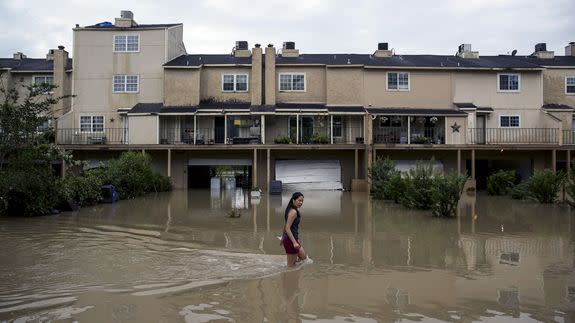Five soldiers dead, others missing amid record flooding in Texas

At least five Fort Hood soldiers died on Thursday and four more were still missing on Friday after rushing floodwater flipped over a military truck during a training exercise at the Texas military base.
Three more soldiers were taken to the hospital and treated for non-life-threatening injuries.
The incident comes as the state continues to be inundated by heavy rains that have sent rivers to record heights, only two years after many of them ran dry in a record drought.
SEE ALSO: As floodwaters rise, Paris closes the Louvre to protect valuable artwork
Aerial and ground crews were searching the 20-mile creek that winds through heavily wooded terrain on the northern fringe of the base, using aircraft, canine search teams, swift-water rescue watercraft and heavy trucks.
The Army hasn't released the names of the victims because it is still notifying relatives.
More than half of the state is under flood watches or warnings on Friday, including the counties near Fort Hood. At least six people died in floods last week in Central and Southeast Texas.
Fort Hood spokesman John Miller said the creek crossing was flooded by two days of intermittent heavy rains when the floodwaters swept the Light Medium Tactical Vehicle from the road.
The vehicle resembles a flatbed truck with a walled bed and is used to carry troops.
Texas Governor Greg Abbott issued a statement saying the state "stands ready to provide any assistance to Fort Hood as they deal with this tragedy."

Image: NOAA
Across Texas, many were watching a new batch of storms that could dump up to 10 inches of rain through Saturday and worsen flooding from waterways that already have risen to record levels. For example, the Brazos River near Glen Rose, Texas broke its all-time record level, reaching 35.9 feet on Friday morning.
The same river rose nearly 5 feet above the previous record level when it reached 54.81 feet on Thursday in Richmond, about 30 miles southwest of Houston.
The heaviest rainfall Thursday night was reported in LaPorte, on the western shore of Galveston Bay, where 4.36 inches of rain was recorded between 5 p.m. and 8 p.m. Thursday.
Officials say the Brazos has not dropped much and that additional rainfall could make the flooding worse.
Heavy rains were moving into the Houston area on Friday morning, threatening to worsen flooding there.
"With the rain that's predicted, that's not going to help things as that water has no place to go," said Lt. Lowell Neinast, with the police department in Richmond, where more than 700 people have been evacuated from their homes.
This week's storms are the latest in a string of torrential rains since May 2015 that have put swaths of the state under water. Some areas now overwhelmed by water had run dry two years ago due to drought conditions.
In April, the Houston area saw an unprecedented deluge, with some parts of the metro area picking up nearly 2 feet of rain in a single day.

Image: NOAA
The flooding this time around is the result of a stalled low pressure area in the upper levels of the atmosphere above the Southwest. This low is pulling warm, moist air northward from the Gulf of Mexico and causing the air to rise, cool and condense into heavy showers and thunderstorms.
In addition the the meteorological factors behind the event, climate studies show that long-term, human-caused global warming is making heavy precipitation events — such as what Texas has been experiencing — more common.
Additional reporting by the Associated Press.
